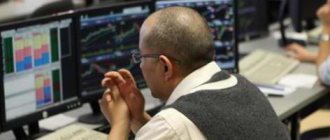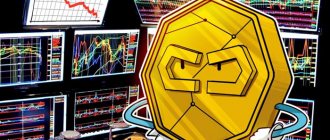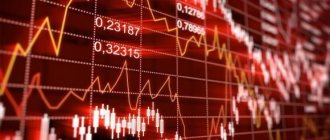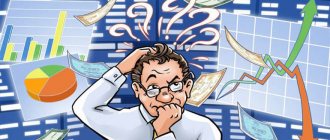Speculation or investment?
The foreign exchange and stock markets are similar in many ways, but there are also key differences. In particular, this is the approach itself - investment or speculative. And if speculative traders predominate in the foreign exchange market, then there are more investors in the stock market.
Speculating on the stock market involves high risk and requires special skills and preparation. Even the most experienced stock traders do not always succeed in making money on the stock market. For example, if you look at the statistics of the “Best Private Investor” competition, which is held annually on the Moscow Exchange, then in 2019 56% of traders were left without profit, and only 7% of participants managed to earn more than 100 thousand rubles. In 2020, the LCI competition ended for 82% of traders without profit or loss.
For this reason, we will consider income from investments in the securities market, excluding the speculative part.
Earnings on shares of Sberbank and Gazprom
Shares of the specified stock market of the Russian Federation. They demonstrate the highest level of liquidity and are popular among beginners and experienced traders. In the long term, the shares bring stable profits, and dividends are also paid to shareholders.
One share of Gazprom currently costs about 249 rubles, and one share of Sberbank costs 241 rubles. The minimum threshold for most brokers is several thousand rubles, so you can buy a certain number of shares of these issuers. Within a year, thanks to the increased cost, they can be sold profitably or the level of profitability can be assessed and purchased more.
Investments in shares and OFZ
A bank deposit is, in fact, the simplest way to invest money. However, this method is completely unsuitable for increasing them.
For example, at the end of May 2020, the average maximum rate on ruble deposits of the top 10 Russian banks in this market, according to the Central Bank of the Russian Federation, was 5.039. Moreover, at the June meeting, the Bank of Russia reduced the key rate to 4.5%, which means that in June the average rate on ruble deposits was at the level of 4.5-4.7%.
An alternative to a bank deposit is the purchase of federal loan bonds OFZ . The issuer of these bonds is the state, which guarantees their highest reliability, and the yield on them exceeds the yield on deposits by 2-3 percentage points
Exchange-traded bonds of large banks and companies , are also highly popular among investors . For example, the rate for a ruble deposit in Sberbank at the time of writing is less than 4% per annum. In turn, the exchange-traded bond of the same Sberbank RU000A100758 has a yield of 5.3% per annum.
The third investment option is stocks . The profitability of this asset is higher than the previous two, but the risks are also higher.
An investor who bought shares has the opportunity to profit from the growth in the value of the securities themselves and from the payment of dividends. For example, between 2001 and 2020, Sberbank shares rose in price by 65%, not taking into account dividends.
It is worth noting that not all stocks grow at such a pace - some securities may remain in a narrow price range for years. Also, do not forget that the rule of all financial markets applies to the stock market - profitability in the past is not a guarantee of profit in the future. Therefore, you should approach the selection of stocks to purchase with maximum responsibility.
Types of investment securities
To better understand making money on securities, you need to understand what you have to work with. There are two main types of investment securities.
A share is an equity security that assigns the owner the right to receive profit in the form of dividends and to part of the property in the event of liquidation of the joint-stock company. Often purchased at a price higher than face value.
A bond is a debt security, the owner of which has the right to receive from the issuer (the company that issued it) the right to receive its face value in cash or property equivalent. Bought below face value.
To put it very briefly and simply:
A share is an investment in the authorized capital of a company, obtaining rights to a part of the income and property when the company is closed. A bond is a loan to a company for a certain period of time, after which the funds can be withdrawn with interest.
The main difference between these securities for investors is in risks and returns. Bonds are less risky and less profitable securities. Almost always, large companies and states pay profits on them. Bonds are used to raise funds for a long term.
Stocks are a risky, volatile and profitable type of securities. The price of this security depends not only on the company’s payments, but also on the financial position of the latter, as well as statements from the media, the country’s foreign policy, etc. There are many pitfalls that affect the price of the securities, which is why they are so risky and profitable.
There are also derivatives of the securities market - futures and options.
Futures is a contract in which the seller and buyer undertake to buy and sell an asset on time at a specified price (i.e., a trading contract for future delivery or compensation for the cost if it is non-deliverable).
An option is the right, but not the obligation, to buy a specific asset at a certain time at a predetermined price (almost a futures, but without the obligation).
I would like to say a few words about certificates. Savings and certificates of deposit are investment securities from major banks. The rates on them do not exceed the current deposit offers, so there are no special differences from standard banking products.
There are also bills and checks, but they are used only for lending or for mutual settlements.
Corporate Investments
You can study long and hard the options for buying bonds and shares, but if you don’t have time for this, then the process can be somewhat simplified by purchasing mutual fund units or ETF shares . In this way, you can buy not an individual share of a company, but an entire investment portfolio formed in a certain way.
For example, on the Moscow Exchange you can buy shares of the FXRL ETF, which is formed on the basis of the RTS index, or a share of the exchange-traded mutual fund VTBB, which includes securities from the Moscow Exchange corporate bond index.
Each exchange-traded investment fund issues its shares or units, which are available to private investors at a price of 1,000 rubles.
With the help of mutual funds and ETFs, you can diversify the risks of your investments, and they save a lot of time.
How to make money buying stocks: step-by-step instructions for dummies
Those who want to understand what stocks are and how to make money on them should carefully study the entire process of purchasing an asset. It is important to immediately decide why to buy securities and what to do with them later. You can start with a small amount of a few thousand rubles.
Step 1: Set goals
You cannot invest without a goal - assets that were bought for no apparent reason rarely bring success.
Financial objectives must be clearly formulated, tools must be selected for them, and appropriate actions must be included in the plan. The success of investment activity presupposes the receipt of income - you must immediately decide what it should be, in what time frame it should be received, what it is needed for, etc. Examples of long-term goals can be different - someone simply wants to save and increase funds (therefore, they set themselves the goal of getting 10% profit in a year and choose the appropriate path), others want to save up for real estate, vacation, education, etc. in a year.
What is the purpose for:
- Provides powerful motivation.
- Increases productivity.
- Gives you the opportunity to exercise control over the implementation of your goal and not waste time.
- Gives you self-confidence and gives you a feeling of satisfaction from the work done.
Step 2: choose a broker
A broker is a financial organization with a license and everything necessary to provide individuals with the opportunity to trade on exchanges and markets. It is through an intermediary (and only this way) that a trader can buy/sell shares and enter the stock exchange.
Basic requirements for a broker:
- Good reputation and considerable work experience.
- Availability of a license and all permits to carry out activities.
- The optimal entry threshold is the minimum amount to open an account.
- Small commissions for transactions and for depositing/withdrawing funds.
- Lots of positive reviews from professional traders.
- Availability of convenient trading terminals.
- Access to all necessary exchanges, trading a wide range of instruments.
A trader can find all the information he is interested in on various thematic websites, in broker ratings, and on the resources of the companies themselves. The client/broker relationship is formalized under an agreement (signed remotely, as a rule), consultations are available. After signing the agreement, the broker provides a trading terminal, the ability to open different accounts and start trading.
Key broker functions:
- Keeping records of finances and securities in client accounts.
- Registration of a client on the exchange.
- Providing information to the client regarding the progress of the auction (prices, names, changes, etc.).
- Purchasing/selling shares on behalf of a client.
- Carrying out settlements for transactions - transferring funds to the Central Bank and back.
- Providing reports on financial transactions.
- Issuance of certificates on transactions and taxes.
For services, brokers charge a percentage - a commission on transactions; in the event of bankruptcy of the company, there is no insurance. When figuring out how you can make money, you need to pay special attention to choosing a broker, since not a single successful strategy will work if the broker works dishonestly, does not send orders to the market or even misappropriates funds.
Among the best are Finam, BCS, VTB, Sberbank and others. Without a broker, no individual can trade on the stock exchange.
Step 3: open a demo account
Before starting real trading, it is advisable to practice on a demo account: here you can study and try everything, trade different securities, find out what it is, gaining new knowledge and skills every day. A demo account has all the same conditions as a regular one, just using virtual money to make transactions. Most brokers offer this type of account and you should not ignore this opportunity.
Step 4: investment strategies and investment portfolio formation
Investing can vary and typically the highest returns involve the most risk. That is, with an income of 10% there is almost no risk of losing money, but with 150% it is huge.
Basic investment strategies:
- Conservative – risk level around 10%.
- Moderate – risks reach 30%.
- Aggressive – the risk is high and ranges from 30%.
They choose according to different criteria: mentality and character, availability of free finances, knowledge and skills, obtaining insider information. Any investment needs to be diversified - make up a portfolio of shares of companies of different echelons, areas of work, size, etc.
If you have knowledge regarding the development of different industries, it is advisable to choose “opposite” ones (when one area and the companies operating in it develop, another declines, etc.).
You need to invest in shares of at least 3-4 (and preferably more) companies with different levels of risk. Many experts advise doing this: invest 40% in conservative companies with moderate risk, let high-risk ones make up 20% of the portfolio.
Step 5: Selecting Stocks
Beginners are advised not to take risks and choose “blue chips” for investments - serious corporations with a well-predicted future. Usually they only increase in price, and if they decline, it is insignificant and not for long. Blue chips influence the price of securities of other companies, the entire industry in general. These are Gazprom, Apple, Coca-Cola, etc.
Smaller companies involve higher risks, but can also provide higher returns (due to significant changes in value). A good option would be to buy shares of an ETF fund - this is a portfolio of securities already formed by professionals, a “piece” of which can be purchased by any trader.
An ETF fund is an excellent choice: it relieves the investor of some of the tasks regarding servicing investments, the portfolio is already properly diversified, the entry threshold is relatively small, and the risks are minimal.
Step 6: analyze the stock
Stocks can be analyzed based on a variety of parameters. There are many analysis methods; it is important to choose the most optimal one that allows you to obtain all the necessary data about the instrument.
Two main areas of analysis:
Fundamental – based on the study of the work and development of the issuing company, its main financial indicators. It is necessary to evaluate the material and financial base, development prospects of the sector and the enterprise itself, income level, etc. Here they study more about a specific company and the relevance of investing in it.- Technical – involves working with a price chart: tracking price declines/rises, market sentiment, patterns of price changes, etc.
Each investor chooses the analysis method that suits him or combines both. Thus, the famous businessman Jim Rogers, who managed The Quantum Fund together with George Soros for 30 years, used only the fundamental method and the price of the fund’s assets increased by 30% per year.
When trying to understand how famous investors make money, both types of analysis can be explained as follows: fundamental analysis helps to understand what to buy (through a detailed study of all company indicators), and technical analysis helps to understand when to make a trade (by studying price changes on the chart).
Warren Buffett advised against buying shares of companies whose operating principles are unclear and whose products the trader himself does not use. It is also worth noting that technical analysis is a traditional trading activity and work with charts, quotes, etc.
Step 7: buy shares
The purchase/sale transactions themselves are made in the trading terminal, which the broker provides to the trader. Platforms can be different, the most popular is Quik, so before starting cooperation with a broker, it is advisable to check the availability of the program in the list. Quik gives the trader access to all accounts and features. Transactions are made by clicking on the appropriate buttons that transmit commands to the broker.
How to increase the return on investment?
The Russian government is interested in attracting as many private investors as possible and creates the most convenient conditions for this. In particular, tax benefits have been introduced for investors, with the help of which they can increase the profitability of exchange investments.
For example, the IIA tax deduction is extremely popular among private investors, with which you can return 13% of the amount invested in the IIA (no more than 52 thousand rubles per year).
How much can a novice investor earn on the stock exchange?
You shouldn’t chase some sky-high profitability indicators and rush to get rich by the coming Monday. The return on investment can already be considered good if it exceeds the interest on a bank deposit by 2-3%.
The optimal option for profitability is considered to be profit growth that corresponds to the average market rate. For the Russian stock market, this is approximately 15% per year (average return on the Moscow Exchange index since 2001). In addition, Warren Buffett, a legend in the investment world, is confident in the correctness of this approach, and his experience is worth trusting. And you shouldn’t forget about tax benefits, and this is a significant addition to profits.
Dividend trading tactics
How to start receiving dividends ? It is necessary to study existing action algorithms. Let's look at the five most basic ones.
- Buy and hold is a conservative method. This approach is used by W. Buffett. The logic is simple - you need to choose a good company that has potential for growth and buy shares for your portfolio. The organization will pay lower dividends, in a couple of years the net profit will grow, and the interest on the payment will increase.
- Buying shares on sale. Example: in April 2020, during the sanctions panic, Norilsk Nickel securities were purchased. Since then, the exchange rate has increased by 60%. For 2020, 6% was paid, but relative to the initial investment, the return will be higher.
- Buying shares in advance before the cutoff, as soon as the size of the dividends is known. The board of directors recommended that this percentage be allocated for payments; the share price is affordable, quotes will rise, so you can buy while its price is affordable. This strategy is associated with risks, since the board of directors could recommend, but the meeting of shareholders will not approve. In such a situation, the company's quotes will decline.
- Buying shares in advance, selling before the cutoff. The idea is to buy cheap securities and sell them at the peak, when the price of dividends is included in the quotes, but does not fall to the dividend gap. You refuse to pay dividends and get profit from the growth of stock prices.
- Buy immediately after the cutoff, when a dividend gap occurs. The company's shares are cheaper, this is a kind of sale for those who are ready to wait for an increase in quotes.
Is it possible to get rich quick on the stock market?
The answer to this question is yes. As well as the question - is it possible to win a million dollars in the lottery? Of course, from time to time, some investor or trader manages to hit a huge jackpot on the stock market, but here it is solely a matter of a successful coincidence of many factors, and not of knowledge of the market.
For example, over the 13 years of holding the “Best Private Investor” competitions, 42 thousand people took part in them. And only 44 traders out of 42 thousand managed to make a profit of about 1000%, but were unable to repeat their record in the future.











